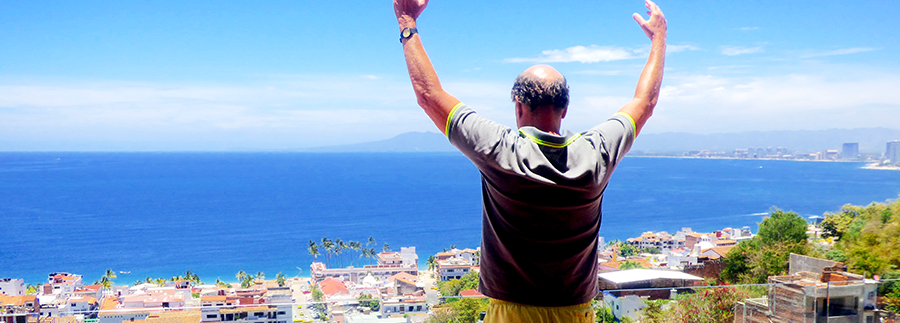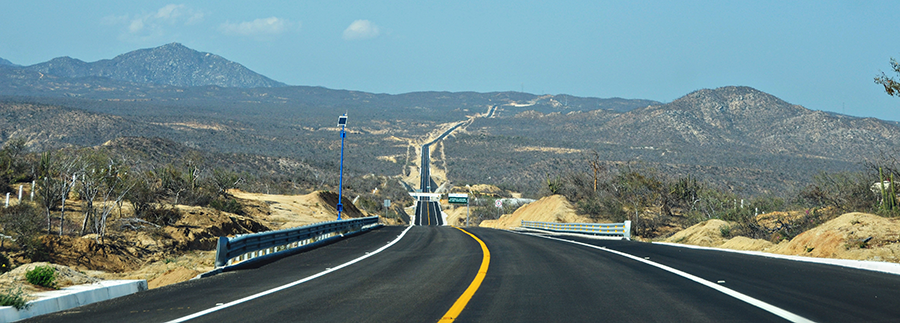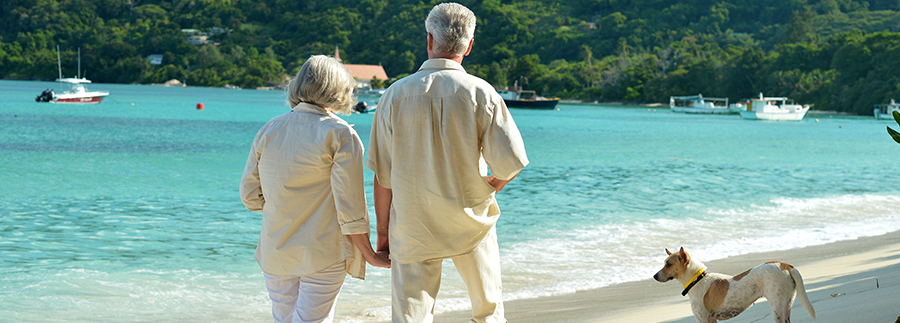Driving in Puerto Vallarta
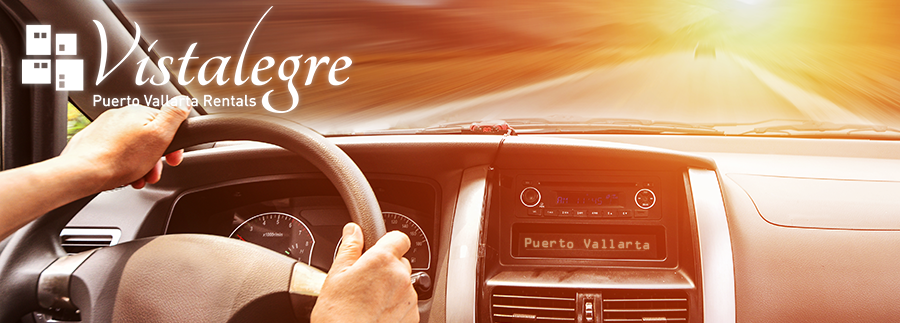
Puerto Vallarta itself represents perhaps the ideal image of a coastal town, but those on an extended stay will find much interest beyond the citys limits. While the public bus system and network of convenient taxis that constantly run through the streets of Puerto Vallarta are outstanding options for transportation, some long term visitors may find that their lifestyles are best served with a personal vehicle during their time in the area.
Using a personal vehicle has advantages including the ability to more easily explore the wider Banderas Bay area, but there are a number of practical aspects that should be considered as well. There are three ways for foreign nationals to obtain a vehicle in Puerto Vallarta: bringing it in from your home country, purchasing it in Mexico or renting a vehicle from one of the areas rental agencies, but there are some basics that every prospective driver in the area must be aware of beforehand.
Road Basics
Much of the driving experience in Puerto Vallarta should be familiar to visitors from the United States and Canada, as traffic runs on the same side of the road as in these countries and road signs are usually similar. An important note for American visitors is that speed limits are posted in kilometers per hour instead of the miles per hour measurement used in the US.
Navigation in the city is simple, with the Sierra Madre mountain range bordering the city to the east and the Pacific Ocean framing the coast to the west, and very few drivers are lost for long. Puerto Vallarta has a well-established network of paved streets in the area of the citys center, but further inland dirt roads are prevalent. Centro Vallarta and Old Town as well as other surrounding neighborhood have cobblestone roads, which should be considered when selecting a vehicle for everyday use.
There are also a number of local road laws that must be obeyed by all motorists. Wearing of a seatbelt is required from the driver at all times to avoid a ticket, and use of cell phones while driving, including voice calls as well as text message, is strictly prohibited. Of course, driving under the influence is also illegal, with offenders risking jail time and other harsh sanctions, and the blood alcohol limit is .08%. All gas stations are federally owned, with the ubiquitous Pemex serving the fuel needs of drivers around the country. Fuel is measured in liters and the prices are standardized at the national level. Gas stations in Mexico are full service, and staff will pump your gasoline for you as well as perform minor maintenance tasks such as window washing and oil level inspection. It is customary to leave a small tip for attendants. Liability insurance is absolutely required on any car, truck or other full size vehicle used in Mexico, and drivers will typically have to obtain a separate policy as domestic coverage rarely extends to driving outside the country in which the policy was purchased. All drivers of a vehicle must be listed on the policy in order for it to take effect in event of an incident on the road.
Topes
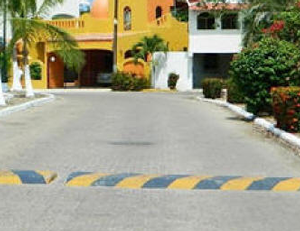 Topes (toh-pays) are speed bumps that are widely employed in the Puerto Vallarta area to help safeguard the safety of pedestrians. These are of particular note because many are not marked clearly and may blend in with the level road at night, and so generally keeping your speed down is a good idea in the most populated areas of the city. Vehicles in front of you can provide a helpful indicator of the presence of hidden topes, and so drivers should be sure to carefully watch the traffic pattern for sudden, temporary slowdowns.
Topes (toh-pays) are speed bumps that are widely employed in the Puerto Vallarta area to help safeguard the safety of pedestrians. These are of particular note because many are not marked clearly and may blend in with the level road at night, and so generally keeping your speed down is a good idea in the most populated areas of the city. Vehicles in front of you can provide a helpful indicator of the presence of hidden topes, and so drivers should be sure to carefully watch the traffic pattern for sudden, temporary slowdowns.
Boulevard Francisco Medina Ascencio
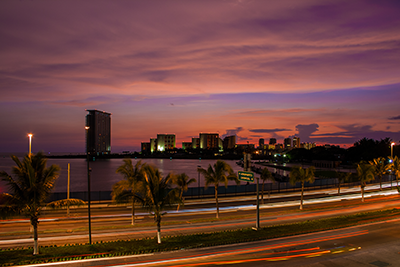 Drivers will also want to be aware of special traffic flow patterns on Boulevard Francisco Medina Ascencio, the main road through the city that extends from the northern end of the Malecon past the airport. Also known as Las Palmas or simply The Main Road, this stretch of highway along the coast has 4 lanes of traffic on each side of the road, two closer to the center for express traffic and two closer to the sidewalk with access to turns onto side streets for local traffic.
Drivers will also want to be aware of special traffic flow patterns on Boulevard Francisco Medina Ascencio, the main road through the city that extends from the northern end of the Malecon past the airport. Also known as Las Palmas or simply The Main Road, this stretch of highway along the coast has 4 lanes of traffic on each side of the road, two closer to the center for express traffic and two closer to the sidewalk with access to turns onto side streets for local traffic.
This means in order to make a turn off The Main Road, drivers must first move into the local traffic lane using one of the sloped exit paths leading out of the express lane. From here, drivers can either make a direct right turn, pass across the lanes of stopped traffic to make a left when indicated by the green turning arrow, or safely make a U-turn into a lane of traffic moving in the opposite direction. All other roads in the city follow standard traffic patterns as dictated by general flow.
Vehicle Rental in Puerto Vallarta
A rental car is best for visitors who may only require occasional use of a vehicle for special trips or who may not want to deal with the extensive registration process to legally own a car in Mexico. In exchange for a deposit to insure against damage, drivers will have use of the vehicle according to the terms of the individual agency. In order to rent a car in Puerto Vallarta, drivers must be in good standing to drive in their licensing countries and have appropriate photo ID, including their passports along with their valid tourist visa.
Buying a Car in Puerto Vallarta
Purchasing a vehicle as a foreigner in Mexico is a slightly more involved process.
Once a desirable vehicle is found, drivers must confirm that it is not stolen by checking its registration number and that its tarjeta de circulation, or federal vehicle documentation, will be valid for the length of the drivers stay in Mexico. All taxes must be paid on a vehicle prior to its valid sale, and the bill of purchase must be transferred and retained.
Once all these materials are in hand, prospective drivers must take the keys along with a copy of a photo ID and federal vehicle documentation to a notary office to confirm transfer of ownership and receive a certificate of ownership. You will need at least a Temporary Resident visa (FM3 and above) to officially register or insure the car as a foreign national within Mexico.
Importing a Vehicle
 Visitors can also bring their own vehicles to the country provided it fits a defined set of criteria. Vehicles imported into Mexico must be made, registered or assembled in North America, including the United States, Canada and Mexico. Visitors on tourist visas can drive their vehicles in Mexico for the length of their stay (180 days), after which the vehicle must be removed from the country.
Visitors can also bring their own vehicles to the country provided it fits a defined set of criteria. Vehicles imported into Mexico must be made, registered or assembled in North America, including the United States, Canada and Mexico. Visitors on tourist visas can drive their vehicles in Mexico for the length of their stay (180 days), after which the vehicle must be removed from the country.
Drivers who plan to be in Puerto Vallarta for a longer period and hold a FM2 or FM3 visa can enter into the full import process to drive their vehicles during their time in the area. Another option is nationalizing the vehicle, which will give it permanent Mexican plates. A nationalized vehicle can also be driven by Mexican nationals and sold within the country. Unlike with other importation statuses, they also do not have to be re-registered on a yearly basis.
Permanent importation of vehicles must be done through a customs broker and can only be pursued by a naturalized immigrant or officially sanctioned long-term resident. Drivers are allowed to import one vehicle every 12 months under standard rules, or they can register as an importer to bring multiple vehicles into the country in a 12 month period. Vehicles that are 29 or more model years old qualify as classic cars, and may be freely transported into the country.
Vehicles must be cleared by Mexican customs before they are driven or otherwise transported into the country, and drivers in the area can register their vehicles locally. In order to have your vehicle processed through customs, drivers must have a government issued photo ID, as well as a copy of their passport and ownership documents such as the vehicle title and registration.
Once your car is in the country, you will have to fax or email copies of the import documentation to your Mexican insurance broker to activate your required policy. Drivers should take exceptional caution to maintain possession of their vehicle importation documents, as failing to handle them properly can have consequences up to and including denial of entry into the country with any personal vehicle.
Traffic Finesf
Should you receive a moving violation while driving in the city, all traffic tickets must be paid at the Transito Municipal building just past the airport. Fines can only be paid at this municipal establishment, and by local law, no traffic violation can be paid directly. An exception to this rule involves rental cars, in which case the ticket must be reported to the rental agency so that they can handle it.
Green Angels
The Green Angels represent an initiative by the Mexican Tourism Ministry to assist travelers in need on the countrys roads.
The Ministry employs a large fleet of distinctive green and white roadside assistance units driven by bilingual drivers to provide a ready resource for stranded motorists. Services from the Green Angels is free, although tipping them up to $20 US depending on the extent of the services rendered is a common practice for motorists in need.
Green Angel drivers vigilantly patrol popular roads from 8am to 8pm carrying identification to offer drivers peace of mind. Motorists can also dial 078 on their mobile phones to have a Green Angels vehicle dispatched directly to their location, and these everyday heroes are equipped to provide light mechanical assistance, towing, first aid and general assistance.
Driving a personal vehicle in Puerto Vallarta is an excellent way to discover even more of what the Banderas Bay area has to offer. There may be no better place for a leisurely drive to nowhere in particular than the sunny Mexican coast!
Read More Blog Entries
Back To Topics



